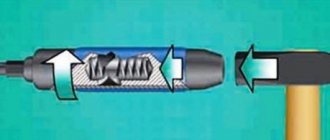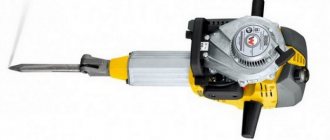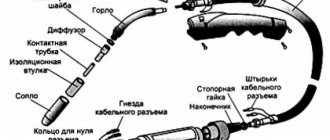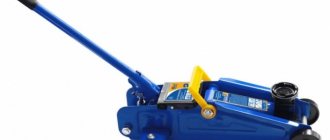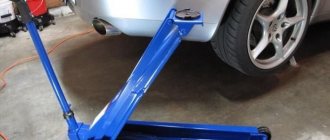Purpose of a hydraulic jack
A hydraulic jack is a stationary, portable or mobile lifting device designed for heavy objects. It is used when performing repair and construction work and as part of cranes, presses, and lifts.
Modern designs of hydraulic devices are used in the oil refining industry, facilities in the energy sector of industry, and in agriculture. The high level of performance and efficiency, ease of operation and maintenance allow the use of hydraulic jacks in the domestic sphere.
This type of equipment can easily function in both horizontal and vertical positions, which has found its application on sites for installation and construction work. The unit is used for tensioning reinforcement structures made of stressed concrete.
Hydraulic lifting device design
Design of a bottle type hydraulic jack.
The unit is designed as follows:
- frame;
- working fluid;
- working piston.
The design of the device can have an elongated or short body, for the manufacture of which hardened special steel is used. The body of the device is assigned to perform several functions. It is a guide cylinder for the working piston and serves as a reservoir for storing working fluid.
A screw with a lifting heel is capable of being screwed into the plunger using a special thread. By unscrewing it, you can change the maximum lifting height of the jack heel. Hydraulic devices are equipped with working pumps that have a manual, foot or air drive. The design provides for the installation of safety valves and some structural elements that ensure long-term and trouble-free operation of the lift.
The hydraulic pump and cylinder with piston are designed in such a way that they ensure the extension and lifting of the special platform. After the rod has been extended, the return to the initial position is carried out using a bypass valve.
Detailed design of a hydraulic jack.
There are several different modifications of hydraulic lifting units, which have their own areas of application.
The most common are:
- bottle type devices;
- rolling-type devices;
- hydraulic jacks of hybrid design;
- hook-type units;
- diamond aggregates.
Various designs of hydraulic jacks have their own characteristics in the device, which are determined by the area of application of the device.
Each type of hydraulic jack is designed differently, however, the operating principle is the same for all.
Classification and comparative points
This issue should also be given attention, because it reveals the main differences between hydraulic and other similar devices.
Bottle devices
Jacks of this type have a fairly simple design . We can say that it is the most primitive among all the devices found today. Hydraulic bottle jacks are actively used in many areas of human activity, which can be explained by their high load capacity. With their help you can lift loads weighing from 2 to 100 tons.
Vertical versions have high strength characteristics and provide the possibility of using a wide support to perform certain operations. They are most widespread in the truck servicing industry, where they are used to lift trucks or buses.
Rolling mechanisms
This group of lifting mechanisms is also one of the most popular. Most often they are used in the automotive industry . In the design of these devices, the cylinder axis is not located in a vertical plane, but is connected directly to the jack lever. These devices are necessarily equipped with wheels that allow them to be moved on any surface.
Lifting mechanisms of this type are characterized by high load capacity. They are also very convenient to use. They work on the same principle as all other jacks. In terms of their design, rolling hydraulic jacks are almost no different from their bottle counterparts.
Hydraulic hybrids
These versions of jacks are most widespread in the field of car service, where they are used to carry out repair work of varying degrees of complexity and on a wide variety of cars. One of the features of these devices is the presence of two working platforms. They are useful when you need to lift a passenger car, and then some kind of gazelle.
This is an excellent choice for professionals. Such models combine the capabilities of a bottle jack and a rolling jack. Thanks to the fact that their capabilities could be embodied in one multifunctional device, buyers have the opportunity to purchase an indispensable assistant and save a lot on it. These devices are as easy to use as any other and can be operated using a hand lever or a foot pedal.
Hitch jacks
Most often, these mechanisms are used in cases where a small picking force is required . They are great for lifting any equipment. They can also be used in the process of assembling complex mechanisms, where a small pick-up height is required.
Diamond devices
Lifting mechanisms of this type are most in demand among car enthusiasts who need a device to lift their vehicle. These mechanisms are highly reliable. In their design, they look exactly like diamond-shaped screw jacks. Every car enthusiast will be happy to have such an assistant in the garage. In the design of these devices, four levers perform the functions of load-bearing elements.
Operating principle of hydraulic lifting device
The operating principle of a hydraulic jack is based on the use in the design of the apparatus of communicating vessels with a working fluid, the role of which is played by a special oil. Before use, the device must be placed on a flat, hard surface and the bypass valve must be closed. After installing and preparing the unit, you can use it for work.
The operating principle of a hydraulic lifting device.
The rod and heel are lifted using a pump that forces working fluid into a special cylinder.
Due to the property of the liquid to resist compression when pressure increases, the piston moves in the working cylinder. This leads to the movement of the rod with the lifting heel. The latter is released by opening the bypass valve counterclockwise.
Pumping of working oil is carried out by a drive pump and a lever mounted on it. Oil moves from the pump to the working cylinder through a special valve.
The return of liquid during operation of the device is prevented by two valves: discharge and suction.
To install the lift in its original position, a special valve is provided in its design, when opened, the working fluid flows from the cylinder into the pump of the unit.
The presence of a screw in the jack device under the working heel allows you to expand the possibilities of using the device.
To carry out lifting, a special heel is made of high-strength steel. The hydraulic jack force is adjusted using a built-in pressure gauge.
Reasons why a hydraulic jack may fail
Repair work on bottle devices is carried out at home with your own hands, but to do this you need to familiarize yourself with all possible malfunctions and the rules for eliminating them. You must first prepare new parts to replace those that have become unusable.
Important!
As soon as the hydraulic cylinder has become unusable, it is necessary to remove the reservoir with the working fluid and disconnect the piston.
Using wrenches you need to unscrew all the bolts and cuffs that are located in the upper part of the main cylinder. After all protective rings have been removed and the reservoir has been pulled out, the lift should be inspected for damage. Replacement bolts are selected in strict accordance with the dimensions of standard parts, and the bushings must be round.
If the top ring has come off, you need to detach the top lining under the jack and carefully inspect it. Using keys, unscrew the screws and install a new rod. To improve fixation, it is recommended to use sealing sheets. When the lower ring flies out, remove the lower frame and also check the integrity of the hydraulic cylinder. The piston should move smoothly, without jamming.
To unscrew the frame, the lift must be turned over and then securely fastened. The sealing ring is carefully inspected, and only then the cover is removed. The extension that extends is dismantled using a Phillips screwdriver, and the side is also inspected for damage.
Jack repair at home
Another common cause of malfunction is a broken traction arm. In this case, it is necessary to remove not only the short cylinder, but also the traction device. If damage or scratches are found on the cylinder or moving plate, the parts must be replaced. The traction device, to which the lever is connected, is located on the underside of the plate, and to remove it, the rod must be released. After the repair work has been carried out, the toggle switch must be secured to the lifting device using a rubber band for the jack.
To avoid premature breakdowns of the hydraulic bottle jack, it is recommended to periodically lubricate all its parts. It is strictly forbidden for dirt to accumulate in the jack support, as this may cause the device to jam. Only if the structure is properly stored will it serve for a long period of time.
Advantages and disadvantages of hydraulic jacks
The physical properties of the liquid allow for smooth lifting and lowering of the load and fixing it at a certain height. Hydraulic jacks provide a high efficiency rate, which reaches 80%. The load capacity of the unit is due to the presence of a large gear ratio between the cross-sectional parameters of the pump and working cylinder and plunger.
It is necessary to regularly wash the hydraulic jack, as well as change the oil and pump it.
Hydraulic lifts have a number of disadvantages. First of all, it should be noted that any model of this equipment has a certain starting height for lifting the load, below which the device cannot be operated. The disadvantage of this equipment is also the inability to accurately adjust the lowering height. In order to ensure uninterrupted operation of the device, it is recommended to constantly monitor the cleanliness, quality and level of oil in the jack reservoir. The normal operation of the device is ensured by the tightness of the valves and seals used in the design of the unit. The device must be transported and stored exclusively in a vertical position; if this requirement is violated, the working fluid may leak out of the device’s reservoir.
One of the disadvantages is the slowness of the units in operation. The disadvantages also include the weight of the device, its large size and high cost. In addition, single-plunger devices have a small stroke of the working rod, which is another disadvantage.
Hydraulic jack device
To make a calculation of a hydraulic jack for its purchase or self-assembly, it is recommended to find out what the circuit, structure and design features of this device are.
The lifting device consists of three main components:
- Movable piston;
- Cases. It is made of high-strength metal and has the shape of a cylinder. In addition to the functions of the housing, it plays the role of a container where the oil is located;
- Liquid medium. Its role is played by machine oil;
- Levers;
- Valves;
- Plungers.
- Force is applied to the lever, and the use of valves makes it possible to increase it tens of times.
- The plunger allows you to move the piston device by transferring the working fluid, which is oil, into a container under the plunger.
- Due to the valve, oil does not flow back into the housing.
- Gradually, the plunger transfers more oil under the piston, which helps it rise.
- To lower the load, the oil must return to the housing structure. Here you need to open the valve slightly.
A similar operating principle is relevant for all hydraulic jacks. Therefore, the diagram, drawings, video manuals for assembly and operation of these devices are approximately the same.
Advantages and disadvantages
If you decide to assemble a device for lifting bottle-type loads, thereby creating a hydraulic jack, or want to buy factory equipment, you should first find out about the strengths and weaknesses that characterize the device.
Let's start with the advantages, which include:
- High power levels;
- Ease of operation;
- High efficiency, reaching 80 percent;
- The device operates when moving loads weighing up to 200 tons. So the hydraulic jack lifts a decent amount of weight.
But this type of jack has its drawbacks. You should know them before you start working on it.
- The device cannot lift loads from low heights.
- Inability to set the lowering level of parts.
- A device of this type requires close attention and periodic maintenance. The service plan provides for the need to fill in oil, change seals and gaskets.
- The hydraulic jack can only be transported and stored if it is positioned vertically. Otherwise, oil leaks out and must be refilled for normal operation. Refueling the unit is not difficult, but no one wants to do it all the time.
- The principle of the device does not allow it to quickly perform the functions of raising and lowering.
- The rise is carried out cyclically.
- This type of device is quite expensive.
- Breakdowns are not uncommon for hydraulic jacks, and they are quite expensive to maintain.
Read also: Which compressors are better oil or oil-free

